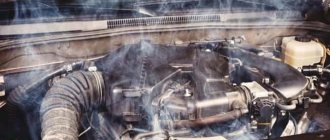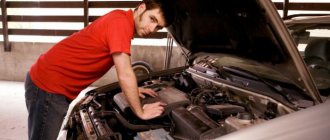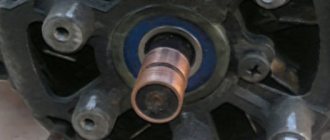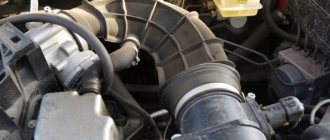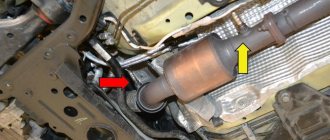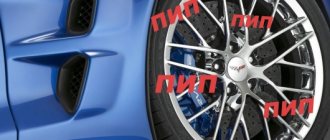Quite a lot of car owners are wondering how to check the pump without removing it from the engine. After all, it is highly not recommended to mess around with the cooling system, so it’s worth learning how to check it directly on the car. Please note that this will minimize repair time and also make it possible to avoid unnecessary costs for unnecessary components. Even a completely inexperienced driver can carry out such diagnostics, which will make his task easier, especially if the engine suddenly heats up. Do not delay carrying out diagnostic work; remember that overheating of the power plant leads to its rapid failure.
How to check the pump without removing it from the engine is actually a fairly simple question. There shouldn't be any problems with this. But, you need to know how this system works. Careful study of the work process will greatly simplify the diagnostic process. Another point that should not be forgotten is the ability to carry out such diagnostics at any convenient time. Even if you are on the road in a deserted area, you can conduct a check and decide on further movement.
Technical features
First, let's look at the main technical characteristics and features of the water pump; this will allow us not only to make a correct diagnosis, but also to understand why the breakdown occurred.
Antifreeze is pumped using an impeller, which is mounted on a shaft. The drive is carried out from the crankshaft of the motor; a belt drive is used for this. Here it is worth clarifying that in practice there are 2 drive methods used for the pump:
- Directly from the crankshaft
. This method is used on engines with a timing chain. Usually one belt drives the generator and pump, sometimes the power steering and air conditioning pump are also connected here; - Another option is timing belt drive.
There is one serious drawback here. When the bearing jams in the pump, the belt breaks, which leads to breakdown of the gas distribution system, and under certain conditions, to a complete overhaul of the engine. In this case, you should carefully monitor the condition of the pump.
The pump housing is usually located at the front of the motor. This allows for the most optimal pumping of coolant through the system. It is also precisely this approach that makes it possible to use the crankshaft pulley as a moving element. In addition, placing the part at the front makes it easier to access for repairs.
The main malfunctions of the pump are directly related to its technical features; accordingly, this must be taken into account when carrying out diagnostic actions. As a rule, all signs of a malfunction are completely related to the characteristics of the various elements that ensure the operation of your car's cooling system.
Where to begin?
There are certain signs of a VAZ pump malfunction. In these models, the pump ensures the movement of antifreeze along the cooling jacket circuit, lines and pipes, as well as through the radiator. During the warm season, even a slight malfunction of the pump can lead to overheating.
It is worth noting that signs of a pump malfunction on the VAZ-2112, 2107, 2109, 2114 and some other models need to be able to be identified as soon as possible. The fact is that in these models the pump is driven by a timing belt. If the pump jams for some reason, it will break. This, in turn, leads to deformation of the valves on the engine. This situation is observed in most cases when such a breakdown occurs. Therefore, it is important to independently recognize the signs of a pump malfunction in the cooling system.
How to check?
An important point is to check the pump. Many car enthusiasts believe that in order to diagnose it, it is necessary to dismantle the part, but in most cases you can do without this. There are a number of signs by which you can understand that the problem is in the pump. To begin with, it is worth noting that most manufacturers recommend replacing the water pump after 60-80 thousand kilometers
. In some cases, regulations indicate the need to replace simultaneously with the timing belt. Therefore, if the pump on your car has gone through such a mileage, then it makes sense to replace it at the first opportunity.
Please note that using low-quality antifreeze or mixing incompatible types of coolant can lead to increased wear on the pump. Therefore, always pay attention to the composition of the liquid you use for cooling.
Diagnostics is carried out in the following order
:
- Start the engine and warm it up to operating temperature;
- Next, pinch the pipe
that goes from the radiator to the pump with your hand. When the pump is fully operational, you will feel the pressure it creates. Usually, this is felt in the form of fairly strong tremors. If they are, then there are no problems with the water pump; - If the shocks are weak or completely absent, then you need to move on to a more thorough inspection of the pump. Turn off the engine; on some models you will need to remove the timing case. Pay attention to the presence of leaks near the pump mounting location; antifreeze may also leak through the pulley seal. If there are such signs, then it is definitely necessary to remove the pump and troubleshoot it.
Do-it-yourself pump replacement on VAZ cars
As mentioned above, the replacement procedure will look different on different car models. This is due to the location of the unit in the engine compartment and the design of the car itself. The easiest way to perform the replacement is on VAZ cars.
To replace the pump you only need wrenches
The replacement procedure is as follows:
- Wait until the engine cools down. It is prohibited to carry out work immediately after stopping the engine, as you may get burned.
- Prepare a set of wrenches and a container to drain the old coolant. It is necessary to change the pump together with antifreeze (antifreeze), since the old liquid gradually loses its cooling properties during use.
- Unscrew the antifreeze drain plug (the plug is located on the engine block). After this, unscrew the cap on the radiator to quickly get rid of the old fluid. Place containers under the drain points.
- When the antifreeze (antifreeze) stops dripping, loosen the generator belt tension rack. After this, remove the belt, since otherwise it will be impossible to get close to the pump.
- Remove the three pulley bolts. Remove the alternator belt pulley. Unscrew the nuts that secure the part to the motor housing. Take out the pump and along with it the old gasket.
- After this, it is recommended to wipe the seating area with a clean cloth and install a new rubber gasket. To ensure secure fastening, it is better to treat the socket with sealant.
- Install the new pump on a new gasket and then carry out all work in the reverse order. Upon completion of work, fill in new coolant.
Dismantling and installation of the product on VAZ cars takes about an hour. On cars of other brands, the work may take longer due to the fact that you will have to unscrew the engine mounts.
How much does it cost to replace a pump at a service station?
It is necessary to separately say that replacement in itself is not a costly operation. Specialists from service organizations charge from 1,200 to 3,000 rubles for their services, depending on the make of the car.
I changed it myself on a 124 engine, I changed it on an 8-valve engine with a friend on his ten... I still don’t understand what the 1200 came out of... Whatever it was, it took an hour with breaks. I’ll even say more - I recently changed the pump itself on the m50b20 in my BMW, it took about 40 minutes.. The service asked for inadequate money for this work... Although in fact it’s easier to change the pump on a BMW than on the former 21124..
Possible faults
Now let's look at the main malfunctions of the pump; all problems have their own signs, knowledge of them will allow us to make more competent diagnostics. So, most often drivers face the following reasons:
- Depressurization of a part
. In this case, the coolant leaves through the shaft seal or through the gasket. Here there is a decrease in the efficiency of the pump; part of the pressure is lost due to a leak. With such a malfunction, antifreeze drips are often observed, and it also quickly leaves the system; - Bearing wear
. The shaft on which the impeller is mounted has a bearing, which wears out over time and may fail. Bearing jamming, as already mentioned, on some engines can lead to a number of serious breakdowns. It is worth considering that this problem can manifest itself in different ways. Most often, the bearing begins to howl, this is due to the depletion of lubricant, as well as a high level of wear of the race. But sometimes a breakdown manifests itself as a knock. This happens when the bearing is completely or partially destroyed. Another possible malfunction is a jammed bearing, in which case the pump cannot be turned; - Impeller destruction
. This is a rare malfunction, but it does happen. The reason is the poor quality of the part. With such a breakdown, a strong roar is observed immediately after starting the engine, and the car quickly overheats.
Rust, deposits
Signs of a malfunction of the VAZ-2110, 2114 or other car models may be different. When examining the pump externally, you can notice rust. Most often, corrosion affects the impeller blades. This leads to a decrease in the rate of pumping antifreeze in the system. The cause of rust may be dirty coolant or a composition that is incompatible with the pump. Mixing antifreeze with different chemical compositions can also lead to a similar malfunction.
Another reason for rust on the pump may be damage to its cover. In this case, it will not be able to close hermetically. Because of this, air bubbles appear in the composition, which causes oxidative processes.
In this case, the pump will need to be replaced. The cooling system will need to be thoroughly flushed and filled with new antifreeze. You need to check the lid for tightness. It may need to be replaced.
You also need to replace the pump if deposits appear on the internal surfaces. Such signs of malfunction of a pump 2114, 2110 or another model can only be assessed by visual inspection of the system. Resinous, mineral or other deposits appear on the internal surfaces of the pump. They clog the pump and prevent the system from working properly.
The reason for this malfunction lies in contamination of the antifreeze or the use of an inappropriate composition. The system must be thoroughly flushed using special compounds. The pump is replaced and new high quality antifreeze is added.
How to fix the problem?
If a malfunction is identified, it should be eliminated as soon as possible. Here it is worth understanding that the pump is still a consumable, and in most cases it is easier to completely replace it.
If there is a leak through the gasket, simply remove the pump and replace the gasket. Please note that normal tightness is required here. Therefore, be sure to carefully tighten the fastening nuts. Many drivers lubricate the gasket with sealant; such a precaution will not be superfluous. This will significantly reduce the risk of leakage. After some time, you should check the tightness of the nuts; they may loosen due to engine vibration.
If the cause is the bearing or impeller, then the best solution is to replace the water pump. Repair in this case is complicated, but its effectiveness is low, so it is better to buy a new part and install it. Don’t forget to bleed the cooling system after replacing the pump; this will remove all air pockets, which will increase its efficiency.
conclusions
. The cooling system must operate at maximum efficiency, otherwise engine problems will occur. Therefore, it is simply necessary to know how to check the pump without removing it from the engine. This will avoid costly repairs to the power unit and save you a lot of money.
| The heater does not heat well, the coolant level drops below the MIN mark each time, the engine temperature does not rise to operating temperature, or the engine overheats? The causes of all these ailments are improper operation of the engine cooling system (ECS). We learn to identify and eliminate the causes of poor performance of the LADA Kalina SOD. |
Installing an additional pump on a Sharan stove video
Subscribe to a topic Notification by e-mail about replies to a topic during your absence from the forum.
Subscribe to this forum Notification by e-mail about new topics on the forum during your absence from the forum.
COLD OVEN?! install an ADDITIONAL PUMP, an electric pump from Gazelle (Bosch) and you will be HAPPY!
Repair of additional pump VW Sharan. Article “Repair of an additional electric pump for the cooling system of VW Sharan 1.9 TDI 2002” in text form https://mens-time.com/remont-dopolnitelnogo-elektro-nasosa-vw-sharan/ Volkswagen repair, vw, vw repair, Volkswagen repair, Sharan repair, Sharan.
Add a comment
We recommend looking for another video: Repairing an additional pump
November 20, 2014, 10:09 pm #1 123
THE OVEN ON THE Volkswagen SHARAN WORKS BADLY AND IT ONLY BLOWS A LITTLE WARM WHEN DRIVING. OVEN RADIATOR IS NEW. THE AIR CLOGGER KICKED OUT. THE FLAPES ARE GOOD. WHAT TO DO? IS IT POSSIBLE TO INSTALL AN ADDITIONAL FORCED PUMP FOR THE COOL. JEW.
Andrew ha
- Posts: 13578
- From: village. Scout Kemerovo region
November 20, 2014, 10:36 pm #2 123
Was it worse before replacing the radiator than now?
November 21, 2014, 00:56 #3 123
smarinchenko2014yndexru, November 20, 2014, 22:09, #1
THE OVEN ON THE Volkswagen SHARAN WORKS BADLY AND IT ONLY BLOWS A LITTLE WARM WHEN DRIVING. OVEN RADIATOR IS NEW. THE AIR CLOGGER KICKED OUT. THE FLAPES ARE GOOD. WHAT TO DO? IS IT POSSIBLE TO INSTALL AN ADDITIONAL FORCED PUMP FOR THE COOL. JEW.
New does not mean good)
November 24, 2014, 21:10 #4 123
Before replacing the radiator, I don’t know how it was. The radiator was leaking and I changed it as soon as I bought it and it was still warm. This is such a petrenka.
November 29, 2014, 10:55 #5 123
Guys, what a joy! I made a stove! Now Africa is in the salon! If anyone has problems with the stove, please contact us. I have a Volkswagen Sharan 1999. 2.8 automatic
- Posts: 19
- From: Stolin
- Citroen Xantia 1.6i
December 7, 2014, 5:13 pm #6 123
Well, now tell everyone how you made the stove, what was the reason?
December 9, 2014, 09:44 #7 123
it's simple. after all the operations I described above, I bought the usual extra. pump from gazelle/tk. I didn’t know if it would bring the desired result and if it was the cheapest in price. I put it on the outlet pipe and everything worked - it’s warm in the car! The Gazelle pump has some disadvantages - it needs to be inspected periodically because it may leak and hum during operation, but replacing it if necessary is not a problem.
December 9, 2014, 16:18 #8 123
smarinchenko2014yndexru, December 9, 2014, 09:44, #7
it's simple. After all the operations I described above, I bought a regular additional heating pump from a gazelle / because I didn’t know if it would bring the desired result and if it was the cheapest in price. I put it on the outlet pipe and everything worked - it’s warm in the car! The Gazelle pump has some disadvantages - it needs to be inspected periodically because it may leak and hum during operation, but replacing it if necessary is not a problem.
buzzing, is it tolerable? masters, too, install an additional pump and don’t worry anymore.
gazelle and cheap. There is a universal stlit, although it is 2 times more expensive. but is there any difference?
December 18, 2014, 12:04 #9 123
The hum of this pump lets me know. that it works is also a plus. It's kind of buzzing. then don't interfere.
- Posts: 78
- Geely MK New
December 18, 2014, 16:58 #10 123
five points ))
December 31, 2014, 21:34 #11 123
Vw Sharan 2.0 tdi 103 kw 140 ps.Eberspächer D5Z-f dogrevatel. I have the same problem, the stoves don’t really heat the rear a little more than the front, the additional pump hums like it’s dead (connected directly from the battery), it doesn’t turn on itself when the combustion is turned off, nor does the afterheater turn off after about 2 minutes. work due to overheating, the hot tubes cannot be touched (both of them reach the afterheater) and after it, near the back of the stove, for some reason they are cool, temp. shows about 60 degrees, I don’t know, either there is air in the system or the 12V pump must drive fluid when the reheater is running and, in general, when the stove is on. in the workshop they say we don’t know, so cheers, come on in, we’ll do it, everything is clear, they know they don’t want to lose their loaf, but I don’t want to pay money for horseradish, 350 euros will charge the air that has been bled off or a replaced pump. I need some advice on how this pump works
READ Replacing the heater motor for Renault Megane 2
January 6, 2015, 21:50 #12 123
You see, I have a gasoline one, not a diesel one. You already have this heater, but I don’t know how it works and what could happen to it. I just installed it as an additional feature. It helped me on the gas system. At first I connected it simply from the battery. then I connected it from the nearest positive wire and that’s it.
January 7, 2015, 20:16 #13 123
Greetings ! I checked it like this, heated it up to 90 and constantly kept the engine running at speed, above 2000 rpm. You can’t hold your hand near the stove nozzle (HI mode). and the afterheater has worked to the end, you just turn it down to no higher than 1200-1400 rpm. If everything cools down immediately, you won’t be able to keep your hand on the gas again. As you say, the gazelle nose helped you, so I’ll unscrew my 12V pump and see if it stays in the stove pipes are not in vain! I’ll post how I fix it, but I don’t know why it’s buggy. I apologize for the bunch of mistakes, I haven’t written in Russian for 15 years.
January 8, 2015, 11:20 #14 123
Yes Yes. I had similar crap - at speed everything is fine, only when you stop at a traffic light, cold air immediately blows from the stove. You stand at a traffic light, you know, it doesn’t last very long, but the air immediately cools down. Maybe your pump is faulty - change it and let me know. Good luck!
- Posts: 11844
- Where:
January 8, 2015, 11:45 #15 123
The phrase smiled) the hum of this pump makes me understand.
that it works is also yours
plus sign. It's kind of buzzing. then don't interfere.
Everything in Gazelle is buzzing if there is no cause for alarm)
January 8, 2015, 21:15 #16 123
Hi all! I finally found out why the pump wasn't working. I started to stupidly pull out all the fuses in a row and found a burnt one, he s. ka it was. but in the book it’s not indicated and there’s nothing on the fuse cover, in short the stove warmed up as it should, the afterheater started working. As I understand it, without a pump you can only drive it along the highway. Thanks to all.
January 22, 2015, 10:06 pm #17 123
here you see! everything turned out to be simple. Germans are cunning bitches, but reliable!
December 25, 2016, 21:41 #18 123
Guys, there's a problem. The Sharan has a 2.8 engine, the coolant went into the cold, after I topped it up and the stove heating, well, before that I didn’t say that it was warm, now I don’t understand either it’s airy, or there’s not enough antifreeze on the stoves, it’s blowing cold. If anyone has encountered this, please answer.
- Posts: 3545
- From: Zaporozhye
- UAZ Patriot
December 25, 2016, 21:48 #19 123
Air got in most quickly, since the coolant was leaving, and the thermostat was adequate - this is to (well, I didn’t say before that it was warm.)?
December 26, 2016, 07:07 #20 123
YuriyZP, December 25, 2016, 21:48, #19
Air got in most quickly, since the coolant was leaving, and the thermostat was adequate - this is to (well, I didn’t say before that it was warm.)?
I tried to remove the air, but the stove still doesn’t heat up.
- Posts: 3545
- From: Zaporozhye
- UAZ Patriot
December 26, 2016, 20:46 #21 123
zhora, December 26, 2016, 07:07, #20
I tried to remove the air, but the stove still doesn’t heat up.
The stove in the Lada Kalina does not heat well or the additional installation. pumps
Did you try or did you remove it? Is the thermostat alive? Have you tried flushing the heater radiator?
December 22, 2022, 1:52 pm #22 123
You're standing still warm, but you're icy. 2009, diesel.
March 31, 2022, 09:55 #23 123
Hi people. I have a Sharan 1999, 1.9tdi, it didn’t warm up either. The heater did not work, so I removed it. Because for its repair they charged 250 USD. I removed the coolant circulation pump with snow. And I put it on the return line from the front heater radiator. I also changed the radiators. At first, Chinese was cheap. It only warmed up at high speeds. Zapaya Zovotskaya immediately made a noticeable difference. The soldering did not inspire confidence and I bought a new one from Nissan. In combination with a new radiator and additional the pump in the machine became warm. I practically didn’t turn on the rear heater.
Sources:
https://remam.ru/vozdsys/kak-ustroena-pechka-lada-kalina.html https://womaninred.ru/ustanovka-dopolnitelnogo-nasosa-na-pechku-sharana/
Diagnostics of the LADA Kalina engine cooling system
When operating a vehicle, the technical condition of the cooling system can be assessed by looking at the coolant temperature gauge and the fluid level in the expansion tank. A decrease in coolant level is usually caused by a leak in the system. Some cars have a coolant level sensor installed. When the level drops to the MIN mark, the corresponding indicator lamp in the display unit of the on-board monitoring system lights up.
| 1. Checking the coolant level in the expansion tank . The liquid level should be 25 - 30 mm above the MIN mark on the expansion tank body. If the fluid level is at the MIN mark or below, add coolant to the reservoir |
Shaft defects
Among the signs of a malfunctioning water pump, one should note the presence of deformation on the shaft. Upon inspection, it may appear bent or completely destroyed. If it is broken, it means the overload was sudden. Also, imbalances lead to similar consequences.
If the material from which the shaft is made has changed color (most often it acquires a blue tint), this indicates the gradual destruction of the shaft. This occurs due to excessive heat. The reason for this failure is the misalignment of the drive belt. This leads to shaft deformation or even fracture. Due to insufficient quality maintenance, significant vibrations appear in the system.
In this case, the pump is changed, and the belt drive is also checked. All elements of its system need to be inspected. You also need to evaluate the condition of the fan that is located on the pump (if it is provided in the engine system). If it is bent, other deformations are visible on it, this can destroy the shaft. Wear of the fan coupling and spacer ring also lead to a similar outcome.
Description of the design and operating cycle of the pump
Passenger cars are currently equipped with a hydraulic pump that operates on a centrifugal principle. The task of the element is to ensure continuous movement of the refrigerant. Some pump components are located in hard-to-reach places, so an experienced driver should be able to identify the defect without removing the pump.
The device is housed in a durable metal case and consists of the following functional components:
- Bearings : have a limited resource, as they are lubricated with a pre-applied lubricant. On the other hand, they are completely closed to other components, so they take on a minimal part of the impact of negative factors.
- Axle : this element is fixed using the bearings described above.
- Impeller : the main functional element of the unit. Made of metal to ensure the required strength parameters. Continuously rotating, the impeller pumps up the required pressure in the coolant circuit.
- Pulley : transmits rotational impulse directly from the crankshaft to the impeller. Thanks to the pulley, the operating range of rotation of the impeller is maintained. The use of a pulley is beneficial from a design point of view: slippage of the drive belt is minimized.
Now let's schematically describe how it all works. The cooling pump is connected directly to the crankshaft via a belt. From it the device receives a rotational impulse and spins up to the desired range. The rotating part, with the help of wings, pumps up the necessary pressure and forces the coolant to continuously move along the cooling jacket.
Replace or repair?
If signs of pump malfunction appear, it must be replaced. Many drivers do not do this after every 60 thousand km. If the time has come for replacement, but there are no external signs of pump malfunction, you need to perform a thorough check. Often the first signs of failure are observed within the system. So, if the pump blades are made of metal, corrosion appears on them. Traces of mechanical damage will be visible on the plastic elements of the system. Such a device cannot be used in a cooling system. Even if it works now, it will fail very soon.
Some drivers decide to repair the pump. Theoretically, this procedure can be performed, but practically it is impractical. The cost of the pump is quite reasonable. That's why it's easier to buy.
Experts do not recommend repairing the pump, which is driven by the timing belt. Otherwise the pump will not be reliable. The likelihood of its breakdown increases many times over. Due to its breakdown in such a system, the motor may fail. Therefore, it is better not to save money, but to buy a new pump. It will be much more reliable than a refurbished pump.
It is very important to install it correctly in its original place. Particular attention is paid to seals and proper tightening of fasteners. In some cases, a special sealant is used for joints. It eliminates the possibility of leaks. However, the use of the presented material is not always possible. It will not allow you to subsequently loosen the motor for attaching the timing belt on some car models.
Causes of malfunction
The following reasons are identified that affect the deterioration of the mechanism:
- Damage to the rotating components of the impeller : during intensive operation, small wings of the rotating part break off. This is especially true for plastic impellers. When the wings break off, the pump can no longer pump antifreeze at the required intensity - the engine constantly overheats.
- Drain hole clogged . This problem leads to the fact that antifreeze cannot fully circulate through the circuit. Clogged drainage can be easily tracked without removing the pump. If you suspect that the drain holes are clogged, simply turn on the cabin heater.
- De-synchronization of element and timing pulleys . In this case, the seals and bearings work in extreme conditions and wear out extremely quickly. The reason for such a breakdown is a manufacturing defect: either low-quality materials were used during assembly, or an unreliable assembler was used.
We need to speak in more detail about the third reason. No car owner is insured against manufacturing defects. But in this case, everything is serious with the prefix “hyper”. If you install a pump with potential out of sync, then the use of such a defective unit will lead to a sharp increase in timing wear. In the best case, the driver may encounter a broken belt, in the worst case, the valves “knock”.
Another marker of wear (which, however, can only be seen after disassembling the mechanism) is play in the rotating parts. Backlash indicates imminent failure of the pulleys, displacement of the central axis and damage to the seals.
The last life hack for motorists who do not want to remove the pump, but want reliable information about its functional condition. Carefully inspect the junction of the cooler and the internal combustion engine. If there are significant antifreeze leaks, then the water pump does not have long to live.
Cavitation, bearing damage
When considering the signs of a malfunctioning engine pump, one should note such a negative phenomenon as cavitation. This is the process by which bubbles form in antifreeze. They damage internal surfaces and individual parts of the pump. As a result, chipped areas remain on them. Subsequently they become covered with rust.
Air bubbles appear in the pump inlet area. When the pressure in the system increases, they collapse. This process causes significant harm to the entire system. The pump will need to be replaced and the system flushed.
When considering the signs of a malfunction of a VAZ-2114, 2112 or other model pump, it is worth paying attention to such a phenomenon as play on the bearing shaft. You need to check the system after turning off the engine. You need to press down on the bearing by hand. There are no signs of play in a working system. If the pump makes a grinding or squealing noise during operation, this also indicates a bearing failure.
The cause of this malfunction is excessive belt tension. Because of this, a large load is placed on the bearing. This leads to accelerated wear of this part. If the seal at the end of the mechanism is damaged, liquid will penetrate into the bearing. Its lubricant will be washed out.
You need to check the belt, pulleys, alignment and tensioner. If there is a malfunction in this system, it must be corrected. Then the pump is changed. A cheap pump of poor quality can also cause a similar malfunction.
Which pump to choose? Famous manufacturers
The best choice is original products. This is a guarantee that the part will fit the car exactly and will withstand the declared service life. The high cost of such spare parts is usually quite justified.
If you choose from substitutes, buyers often prefer water pumps from European brands:
- SKF;
- Hepu;
- Saleri Sil;
- Valeo.
These parts are made of high-quality metals, they are equipped with impellers and bearings with a long service life. The cost is high, but you don’t have to worry about quality.
You can also take a closer look at the German manufacturer Ruville and the Italian companies Graf and Dolz. Water pumps from the manufacturers Profit, JP Group and Thermotec are also considered normal, but these options are best chosen if you have a limited budget.
If the water pump fails before the time stated by the manufacturer, the reason is a manufacturing defect or the purchase of a fake. We recommend choosing Ruville, Valeo and SKF products.
Replacing a pump in a 16-valve system
If your car has a 16-valve system, changing the pump will be a little more difficult. However, performing this procedure yourself is not difficult.
First you need to dismantle the plastic casing and timing belt casing. To remove the upper parts that separate the pulleys from the cylinder block, you need to perform the steps sequentially. This can only be done after dismantling the timing belt, camshaft pulleys and rollers (tensioner and support). Only then will it be possible to remove the pump.
To be able to get to the lower bolts securing the casing, you will need to remove the right wheel. After this, you can dismantle the pump. Then carry out the same actions as in the previous paragraph. If the pump is installed incorrectly, it will leak. Therefore, it is important to follow the instructions specified by the manufacturer.
Source
